|
|
Motors
I think it's
safe to say, no other motion picture camera in history has had as many motors
available for it as the Eclair NPR. By my count, there are at least 13 different
options listed here and these are just the ones made available in North America.
There may be others I'm not aware of made specifically for use in other parts
of the world.
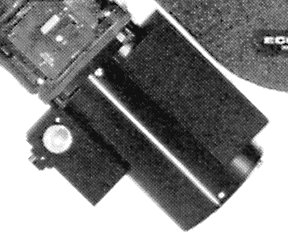 |
The Perfectone Ciblo Motor
By all accounts, this is the original
OEM electric drive motor for the Eclair NPR when it was released in 1963.
Made for Eclair by the Perfectone company of Bienne, Switzerland it was a
very basic, 12v. DC constant speed governor-controlled motor with an accuracy
of .2%. The Ciblo was a 60hz. (for North American use) Pilotone cable
sync motor. This meant it could generate a 60hz. sine wave sync signal
and send it down a cable to a recorder like the Nagra III or IV that was
in direct correlation to the running speed of the drive shaft. At 24fps the
sine wave output was exactly 60hz. If the motor was to vary slightly in speed
the Ciblo's frequency generator would be affected to the very same degree,
thus, altering the 60hz. output by a similar amount. Cable sync was how the
first "portable" double-system sync sound systems operated. You had to have
a cable running between the cameraperson and the sound recordist at all times.
The motor also had an automatic clapper system to fire the fogging lamp
inside the NPR and, at the same time, send an 8v. DC voltage down the same
cable to trigger the recorder's internal bloop oscillator. The motor
required a specially made cradle to secure it to a tripod. Several companies
would later offer after-market crystal sync conversions for the Ciblo (see
below). Perfectone also made a non-sync, variable speed motor for the NPR
that ran from 4-48fps. |
The Eclair AC Sync Motor
Also released as an original OEM motor
option was the Eclair AC sync motor. Available in line voltages of 110v.
AC and 220v. AC, these were known as synchronous motors and were mainly
designed for in-studio use, since they had to be plugged into and electrical
outlet. Their rotational speed was directly tied to the frequency
of the electrical line current they were connected to. A synchronous motor
running on a 110v AC, 60hz line current would drive the NPR at exactly 24fps.
Any number of NPR's using synchronous motors would all be running at exactly
the same speed and, therefore, they would all be in sync with each other.
In fact, this was the very technique used by Michael Wadleigh when he shot
Woodstock '69. At any one time there were as many as 5 cameras all running
off the electrical mains. Even after 3 days of filming, they claim they never
lost one frame of sync! Eclair supposably also released a battery operated,
crystal controlled power-pack for portable operation. This would have been
the forerunner to the self-contained Beala crystal sync motor. |
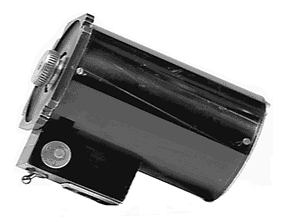 |
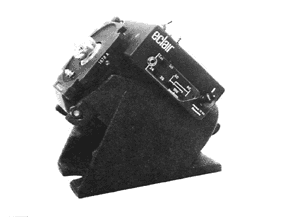 |
The Eclair Beala Motor
Released in 1967, the Beala motor
is named after its inventor, Jean-Pierre Beauviala, later of
Aaton fame. Jean-Pierre worked as a consultant to Eclair before starting
Aaton and is credited with developing the first portable crystal sync sound
recording system using the Eclair NPR. With the introduction of crystal sync,
the cameraperson was now completely free of the cable linking the camera
to the sound recorder. The speed of the NPR was precisely regulated by an
electronic circuit that constantly compared the motor's speed to that of
a quartz crystal oscillator. The accuracy of the motor was now increased
to +-10PPM. The sound recorder, originally the Nagra III, was also fitted
with a crystal oscillator to enable it to record a precise 60hz. sync signal
on the tape along with the audio track. The features included: 24/25fps
selectable crystal speed; 50, 60 or 100hz. pilotone output; both manual and
automatic clapper; stops with the mirror shutter open in the viewfinder position;
out-of-sync warning light; 6-40fps non-sync or wild speed adjustment
with tachometer. The unit pictured is the Beala III sitting in the outboard
tripod cradle. |
The Perfectone Compact Universal
Motor
Offered as an alternative to the Beala,
the Compact Universal made by Perfectone of Switzerland, had almost identical
features and specifications and it was similarly priced when sold as a package
with the NPR. What made this motor a bit more appealing was the drastic reduction
in weight due to its fiberglass housing and that it did not need the outboard
tripod cradle. With its integral flat bottom base, you could simply set NPR
down and walk away. The features included: 24/25fps selectable crystal
speed; 50, 60 or 100hz. pilotone output; both manual and automatic clapper;
internal and external sync reference, stops with the mirror shutter open
in the viewfinder position; out-of-sync warning light; 8-40fps non-sync or
wild speed adjustment with tachometer. |
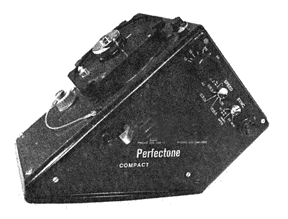 |
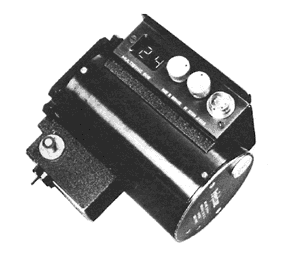 |
The Jensen 508 Ciblo Conversion
Offered by the Georg Jensen company
of Denmark, this was a rather unique crystal sync conversion to the Ciblo
constant speed motor in that it provided a digital readout of the actual
unning speed. The controls included a pot to vary the running speed and a
switch to select between variable, crystal and external sync
input. |
The Aaton Alcan 54 Motor
Taking a rather radical approach to
the physical design, Aaton/Beauviala released their Alcan 54 motor for the
NPR in 1974. By reducing the size of the motor itself and through the use
of miniaturized electronic components, Aaton was able to lower the NPR's
overall profile by some 2.5 inches. The Alcan 54 offered 24 & 25fps crystal
speeds and variable speed from 8 to 40fps. It was designed to stop with the
mirror shutter open in the viewfinder position and would indicate a loss
of crytal sync by producing a pronounced flickering in the viewfinder. A
sliding shoulder pad allowed the operator to adjust the distance between
the users eye and the viewfinder. The unit was equipped to trigger the NPR's
fogging lamp and supply a bloop voltage to a suitably equipped sync recorder
via cable or wireless remote. The motor would sit flat on its base and was
tapped for tripod threads so it did not require a cradle. |
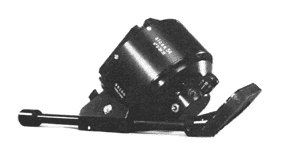 |
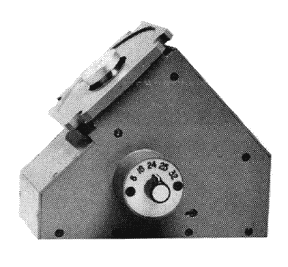 |
The Hafflexx Motor
Appearing sometime around 1975, the
Hafflexx offered five crystal speeds of 8, 16, 24, 25 and 32fps. Taking
their cue from the Perfectone Conpact Universal, Haflexx fashioned their
housing to sit flat with no tripod cradle required. The motor did not offer
any slating functions nor did it provide for cable sync operation. Later
versions of this motor also offered the 29.97fps speed and there was an external
device called Crysdial that used the Arri standard for multi-speed camera
control. The operator could select any crystal speed in .001
increments. |
TheTCS TXM-14 Motor
Tobin Cinema Systems, of Washington
State produced what was probably the most modern, state of the art motor
for the NPR, owing to its many unique features and high-tech manufacturing.
The TXM-14 allows NPR owners to continue shooting with their Eclair and still
match some of the the filming capabilities of today's cameras. The basic
motor s equipped with 15 speeds, all crystal controlled. It included every
60 Hz HMI speed from 12 to 40 FPS and every 50 Hz HMI speed from 10 to 33-1/3
FPS. With the optional Milliframe Controller, the operator could select from
30,000 crystal speeds from 10 to 40 FPS. A less sophisticated Videoframe
Controller offers just the two video related speeds or 23.970 and 23.976.
The accuracy for any speed is ±3 ppm or .0003%. The unit is equipped
with shutter-parking, the term used for stopping the mirror shutter
open in the eyepiece position. Using the same approach as the Perfectone
and Haflexx, the TXM-14 is also designed with a flat bottom base with built
in tripod thread. TCS also offered a crystal sync conversion of the Ciblo
constant speed motor. |
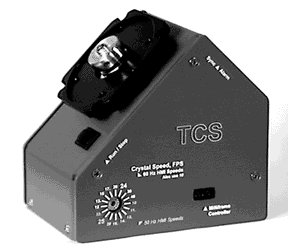 |
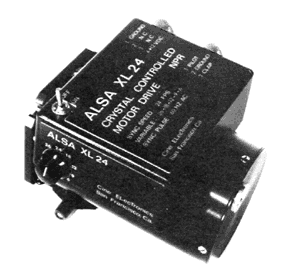 |
The Alsa XL24 Motor
Cine Electronics, of San Francisco,
began producing a motor design similar in appearance to the early Ciblo,
but it was actually manufactured entirely in the United States. Their theory
being the easy and continued supply of replacement parts throughout the life
of the unit. The XL24 offered six crystal speeds: 6, 9, 12, 18, 24 and 36fps.
The motor had an Auto-Take feature that would fog six frames at the
head and six frames at the tail of each take. Like the earlier crystal
sync motors, the XL24 did not forget its roots and still provided a 60hz.
pilotone output and bloop voltage for use with cable-sync recorders. The
XL24 would also stop with the mirror shutter open in the eyepiece
position. |
The Cirpi Motor
Probably the last Beala-style motor
made by Eclair for the NPR, this model appeared around 19XX. Magazine ads
for that period claimed the motor was factory equipped for a time-code option.
The cradle base, long an outboard accessory, was now an integral part of
the motor and housed the additional connectors and electronics. The Cirpi
still offered the same crystal sync speeds of 24 and 25fps and would run
non-sync from 6 to 40fps. |
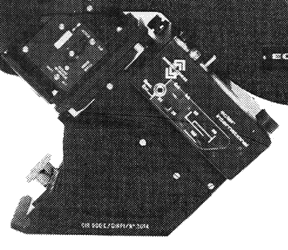 |
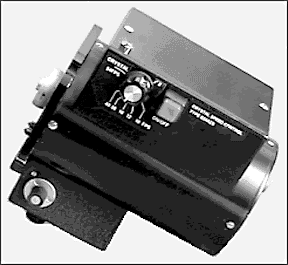 |
The AZ-Spectrum Ciblo Conversion
The AZ Spectrum company in New York
offers two models of their conversion to the Ciblo/Perfectone constant speed
motor. The first provides a single crystal speed of 24 fps and the usual
non-sync, wild speeds of 8-40 fps. The second adds a 2-position binary switch
to allow the operator to select any crystal speed from 8-40fps in 1 fps
increments. Both conversions include the capability to stop with the mirror
shutter open in the eyepiece position. An option to either version is an
industry-standard 11-pin Fischer connector to enable an Arri-compatible external
controller to set the speed of the motor in increments as small as .001fps.
|
In addition to the motors and conversions
shown several companies offered external crystal sync control units. Normally
used with the Ciblo constant speed motor after a conversion, these devices
would be connected to the motor via cables. Companies such as Communication
Arts, Innerspace Systems, Perfectone and Digital Film Equipment all offered
such products.
|
|
|

